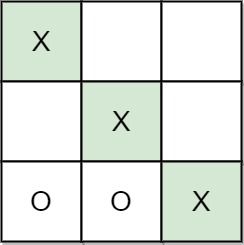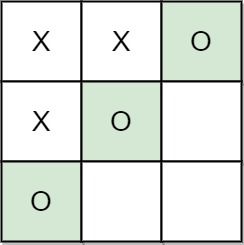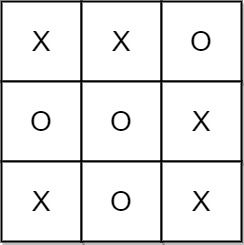Tic-tac-toe is played by two players A and B on a 3 x 3 grid. The rules of Tic-Tac-Toe are:
- Players take turns placing characters into empty squares
' '. - The first player
Aalways places'X'characters, while the second playerBalways places'O'characters. 'X'and'O'characters are always placed into empty squares, never on filled ones.- The game ends when there are three of the same (non-empty) character filling any row, column, or diagonal.
- The game also ends if all squares are non-empty.
- No more moves can be played if the game is over.
Given a 2D integer array moves where moves[i] = [rowi, coli] indicates that the ith move will be played on grid[rowi][coli]. return the winner of the game if it exists (A or B). In case the game ends in a draw return "Draw". If there are still movements to play return "Pending".
You can assume that moves is valid (i.e., it follows the rules of Tic-Tac-Toe), the grid is initially empty, and A will play first.
Example 1:
Input: moves = [[0,0],[2,0],[1,1],[2,1],[2,2]] Output: "A" Explanation: A wins, they always play first.
Example 2:
Input: moves = [[0,0],[1,1],[0,1],[0,2],[1,0],[2,0]] Output: "B" Explanation: B wins.
Example 3:
Input: moves = [[0,0],[1,1],[2,0],[1,0],[1,2],[2,1],[0,1],[0,2],[2,2]] Output: "Draw" Explanation: The game ends in a draw since there are no moves to make.
Constraints:
1 <= moves.length <= 9moves[i].length == 20 <= rowi, coli <= 2- There are no repeated elements on
moves. movesfollow the rules of tic tac toe.
class Solution:
def tictactoe(self, moves: List[List[int]]) -> str:
n = len(moves)
cnt = [0] * 8
for k in range(n - 1, -1, -2):
i, j = moves[k]
cnt[i] += 1
cnt[j + 3] += 1
if i == j:
cnt[6] += 1
if i + j == 2:
cnt[7] += 1
if any(v == 3 for v in cnt):
return "B" if k & 1 else "A"
return "Draw" if n == 9 else "Pending"class Solution {
public String tictactoe(int[][] moves) {
int n = moves.length;
int[] cnt = new int[8];
for (int k = n - 1; k >= 0; k -= 2) {
int i = moves[k][0], j = moves[k][1];
cnt[i]++;
cnt[j + 3]++;
if (i == j) {
cnt[6]++;
}
if (i + j == 2) {
cnt[7]++;
}
if (cnt[i] == 3 || cnt[j + 3] == 3 || cnt[6] == 3 || cnt[7] == 3) {
return k % 2 == 0 ? "A" : "B";
}
}
return n == 9 ? "Draw" : "Pending";
}
}class Solution {
public:
string tictactoe(vector<vector<int>>& moves) {
int n = moves.size();
int cnt[8]{};
for (int k = n - 1; k >= 0; k -= 2) {
int i = moves[k][0], j = moves[k][1];
cnt[i]++;
cnt[j + 3]++;
if (i == j) {
cnt[6]++;
}
if (i + j == 2) {
cnt[7]++;
}
if (cnt[i] == 3 || cnt[j + 3] == 3 || cnt[6] == 3 || cnt[7] == 3) {
return k % 2 == 0 ? "A" : "B";
}
}
return n == 9 ? "Draw" : "Pending";
}
};func tictactoe(moves [][]int) string {
n := len(moves)
cnt := [8]int{}
for k := n - 1; k >= 0; k -= 2 {
i, j := moves[k][0], moves[k][1]
cnt[i]++
cnt[j+3]++
if i == j {
cnt[6]++
}
if i+j == 2 {
cnt[7]++
}
if cnt[i] == 3 || cnt[j+3] == 3 || cnt[6] == 3 || cnt[7] == 3 {
if k%2 == 0 {
return "A"
}
return "B"
}
}
if n == 9 {
return "Draw"
}
return "Pending"
}function tictactoe(moves: number[][]): string {
const n = moves.length;
const cnt = new Array(8).fill(0);
for (let k = n - 1; k >= 0; k -= 2) {
const [i, j] = moves[k];
cnt[i]++;
cnt[j + 3]++;
if (i == j) {
cnt[6]++;
}
if (i + j == 2) {
cnt[7]++;
}
if (cnt[i] == 3 || cnt[j + 3] == 3 || cnt[6] == 3 || cnt[7] == 3) {
return k % 2 == 0 ? 'A' : 'B';
}
}
return n == 9 ? 'Draw' : 'Pending';
}


